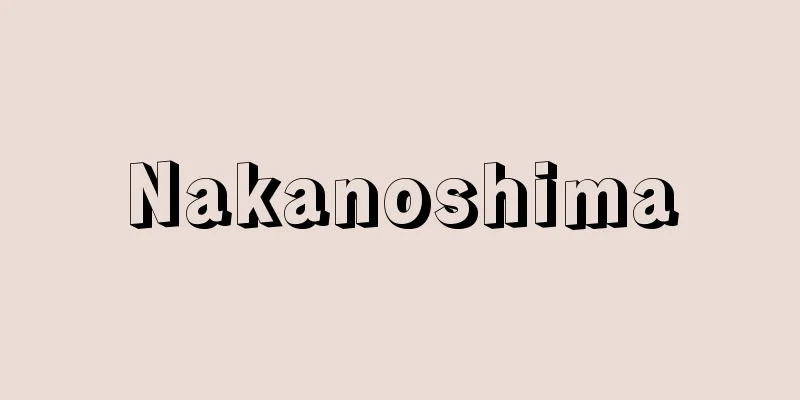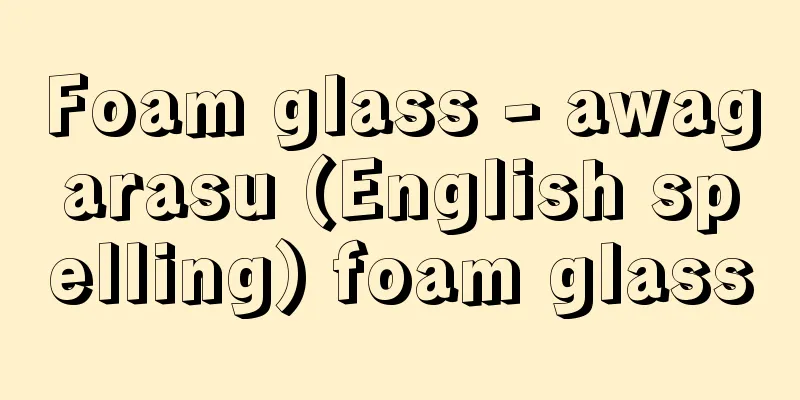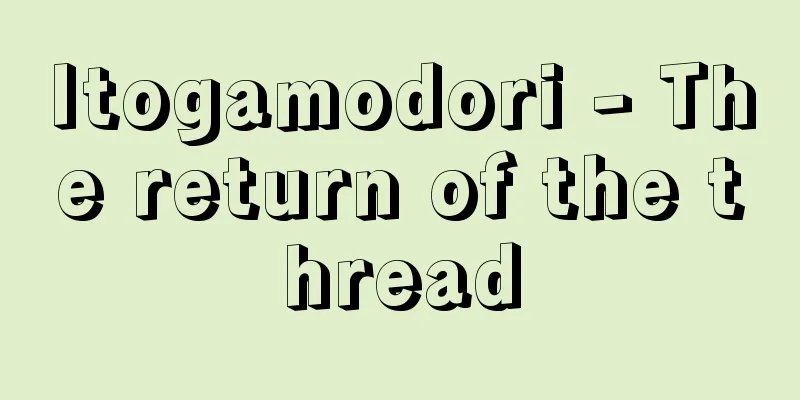Haniwa - Haniwa

|
These are unglazed clay objects that were arranged on the mounds or outer banks of ancient tombs. They are broadly divided into cylindrical haniwa and figurative haniwa (house shapes, people, animals, etc.). [Hirofumi Hashimoto] originThe earliest prototype of cylindrical haniwa was a type of pottery called a "special vessel stand" that was used as a ritual vessel in tombs from the late Yayoi period in the Kibi region (Okayama Prefecture and eastern Hiroshima Prefecture). This vessel stand-shaped pottery for holding jars for food offerings was accepted in the Kinai region when the ancient tombs were created, and it became a formality, degenerating and transforming. The body of a cylindrical haniwa has a protruding band called a "hoop" and a hole between it called a "sukashiana." The holes can be Tomoe-shaped, triangular, square, semicircular, circular, etc., and are remnants of the special vessel stand mentioned above. It was also traditional to paint the exterior red in ancient times. Furthermore, the morning glory-shaped cylindrical haniwa was created by combining the aforementioned pedestal with a stepped rim and bottom-perforated jar that originated in the Kinai region. Meanwhile, house-shaped haniwa seem to have been the earliest figurative haniwa, and examples excavated from the Myotoiwa site (Kurashiki, Okayama Prefecture), a late Yayoi period burial mound in Kibi, are noteworthy. However, there is a time gap between the house-shaped clay product on the pedestal and conventional house-shaped haniwa, and the gap has not been filled. In the case of human-shaped haniwa, the clay doll-shaped product excavated from the Yayoi tumulus in Tatetsuki, Okayama Prefecture, is interesting, but there is a gap between them and human-shaped haniwa from the 5th century. The story of the origin of figurative haniwa, including human-shaped haniwa, is well-known from the entry for the 32nd year of Emperor Suinin in the Nihon Shoki. When Empress Hibasuhime-no-Mikoto died, Nomi no Sukune, the ancestor of the Haji clan, suggested that instead of her committing suicide, clay objects in the shape of people, horses, and various other objects were erected in her tomb. It is also said that they were called "haniwa" or "standing objects." The name "haniwa" is said to have come from the fact that various clay objects were shaped and unglazed, and were arranged in rows like rings in ancient tombs, or that it refers to cylindrical clay objects (cylindrical haniwa) as they are made of clay. Alternatively, it is thought that the name came from the fact that the basic method of shaping various types of haniwa was by stacking and rolling up clay strings. This story about the origin of haniwa does not correspond to archaeological findings on the appearance of various figurative haniwa. It is believed that they were created by the Haji clan, who were engaged in the construction of tombs and the production of haniwa, to honor their ancestors. There is also a theory that they appeared due to the influence of stone people and animals from the continent, in relation to the Chinese figurines and the stone people and horses of northern Kyushu. [Hirofumi Hashimoto] Production methodThe clay strings are wound up or stacked to create hollow shapes, accessories are made by attaching clay blocks, and the eyes and mouths of human figures are carved out with a small knife. House, boat, and utensil haniwa are formed by stacking clay strings or assembling clay slabs. The surface is finished by smoothing with wood chips, spatulas, or fingers. In the case of the former, striations and scratches commonly known as "brush marks" are left due to the influence of the tree rings. Patterns are engraved with a spatula, drawn, or painted before firing. Pigments such as red (red ochre), white (protein stone), and black (unknown) are used to color parts of the clothing, accessories, and carried items. The painted faces and spatula drawings on the human-shaped haniwa figures are said to be makeup and tattoos, but there is also a theory that they were not used in everyday life but for funeral ceremonies. Many of the four-legged animal haniwa are made with four legs, but some, such as the deer-shaped haniwa from Ogawadai Tomb No. 5 in Chiba Prefecture and the dog-shaped haniwa from Tonozuka Tomb, have only one base at the front and one at the back. Bird, fish, vessel and treasure haniwa, and full-body and half-body figures of people are all attached to a single cylindrical pedestal, but there are exceptions, such as some of the full-body figures from Ogawadai Tomb No. 5, which lack a cylindrical pedestal or serve as both, and stand on two legs. There are also examples where the back is omitted. The structure of the head and legs of horse-shaped haniwa and other figures suggests the lineage of the techniques of the production group. Haniwa are generally made in one piece, but there are some special cases, such as those supplied from the Mawatari kiln in Ibaraki Prefecture, where the upper and lower halves of human figures are made separately. The head and shield of the shield-bearing human figure from Tsukamawari No. 1 Tomb in Gunma Prefecture, Hagota, Tawaramoto Town, Shiki County, Nara Prefecture, the shield-shaped figure from Tsukamawari No. 3 Tomb, and the main body and pedestal of the sword-shaped figure are also made separately. This would be suitable for firing and transportation. The completed pieces were dried in the shade in the workshop before being kiln-fired. In the past, they were fired in small hollows dug in the ground, but from the mid-5th century onwards, they were fired at high temperatures of around 900°C in pit kilns that were introduced from the Korean Peninsula. Failed pieces were scraped out into ash piles, and finished products were transported to a collection point attached to the kiln to await the time to be erected into tumuli. In rare cases, cylindrical haniwa and some figurative haniwa have been known to have shaping marks on the outside caused by hammering, as seen on sueki and Korean-style pottery, and marks on the inside caused by the hammering. In these cases, it is believed that sueki artisans and makers of Korean-style pottery were involved in their production. In the Tokai region and elsewhere, there are also so-called "sue-quality haniwa" that were fired in a sueki kiln and turned hard and bluish-gray due to the reducing flames. It is also believed that rituals to the fire god were held at kiln sites, and stone replica sword-shaped objects, perforated circular plates, and mortar balls have been excavated from kiln sites. [Hirofumi Hashimoto] Type and personalityHaniwa do not exist individually, but are combined to express a single world. In particular, human-shaped haniwa are interpreted as depicting (1) substitutes for those who committed suicide, (2) tomb decorations, (3) funeral processions, (4) memorial services, (5) mourning rites, (6) rites for succession to chieftainship, and (7) the state of a person's life. A man kneels in the center, centering on a nobleman who appears to be the chieftain, seated on a chair. Many shrine maidens are depicted sitting on chairs with bells and mirrors hanging from their hands, offering a cup to the chieftain. In rare cases, they are also seen holding large swords. There are festival groups such as women holding offering cups and dancing women, occupational groups such as falconers, cormorants, boar herders, horse herders and farmers, musicians such as drummers, drummers and koto players, warriors such as shield bearers and quiver bearers, and other men and women in full attire taking part in rituals. As for animals, many of them are ceremonial horses with decorative horse gear, in sets with the horse herders mentioned above, but some also depict bare horses or mounted people. There are also many chickens involved in rituals. Dogs with bells around their necks are thought to be hunting dogs, and wounded boars that have been shot with arrows, deer, hawks, waterfowl and fish suggest the king's play related to hunting and fishing - rituals and offerings. Other figures include cows and monkeys. As seen in the example of the Chausuyama Kofun Tumulus in Akabori, Gunma Prefecture, house-shaped haniwa are assumed to represent the various buildings that made up the chief's residence during his lifetime, but there is also the theory that they may have been funeral homes. On the other hand, there are enclosed haniwa, which are L-shaped with a flat, hollow exterior and a mountain-shaped upper edge with two or three horizontal protruding bands around the sides. These were either placed in front of the house-shaped haniwa, or were used to place a representation of a major building within the group. They likely represent the fences, gates, and other outer facilities of the residence. Haniwa objects such as shields, quivers, swords, spears, horns, lids, and shades are considered to be decorations of dignity. Hats and chairs are also available. Furthermore, among the haniwa figures of people from the same burial mound, the difference between full-body and half-body figures is thought to represent high and low social status. Full-body figures of fully dressed men (literati), warriors wearing armor, and fully dressed women are depicted, while farmers, horse keepers, and dancing women are depicted as half-body figures. The types vary depending on the shape of the mound and the period. [Hirofumi Hashimoto] The Appearance and Fall of Various HaniwaVessel-shaped cylindrical haniwa are only found in the Early period. Although they appeared slightly later, ordinary cylindrical haniwa and morning glory-shaped cylindrical haniwa existed for roughly the entire period from the first appearance to the disappearance of haniwa. Oval cylindrical haniwa and finned cylindrical haniwa were erected in large burial mounds from the latter half of the Early period to the first half of the Middle period. Vase-shaped haniwa were made mainly in the Early period, and their numbers decreased dramatically and disappeared from the Middle period onwards. House-shaped haniwa appeared from the Early period, along with enclosure-shaped haniwa. Among vessel and property haniwa, shields, quivers, and lids all appeared in the Early period, and continued into the Middle and Late periods. Armor, helmets, and kusazuri were mainly found in the Middle period, and were no longer made individually in the Late period. Tomo and kage can be seen in the Middle and Late periods, and large swords were newly added to the main sets in the Late period. Among animal-shaped haniwa, chicken-shaped haniwa are oldest and have been known since the end of the Early period, while waterfowl-shaped haniwa are seen in the Middle and Late periods. In connection with the appearance of some animal haniwa, the unearthing of small earthenware objects such as fish-shaped objects from the Middle period is noteworthy. Horse-shaped haniwa seem to have started to appear in the Middle period and became common in the Late period. In addition, many different animal haniwa such as dogs, boars and deer were made in the Late period. Of these, it is suggested that the boar-shaped haniwa are related to the human-shaped haniwa of boar hunters. In some cases, such as at the Hirugami Kurumazuka Tomb in Osaka Prefecture, a dog and boar are placed together to depict hunting scenes. Human-shaped haniwa first appeared in the Middle period and were popular in the Late period, especially in the Kanto region. All of them had disappeared by the beginning of the 7th century. [Hirofumi Hashimoto] ChronologyTraditionally, the view of the chronology of haniwa has been focused on the combination of figurative haniwa, which have differences in appearance. Recently, emphasis has been placed on the changes in the production techniques of cylindrical haniwa, which are universally found in burial mounds that contain haniwa. The chronology is divided into five periods as follows. Phase I (mid-4th century): Secondary adjustment that does not have a standardized external appearance, with four or more holes on each level in the shape of a comma, triangle, rectangle, etc. Phase II (late 4th century): Mainly horizontal brush marks on the outer surface, with circles added to the through holes of Phase I. Highly protruding M-shaped cross section. Phase III (first half of the 5th century): The exterior is mainly covered with intermittent horizontal brush strokes. Until this period, the pottery was burned in the open, resulting in black spots caused by uneven burning. There are also many circular and semicircular holes. Phase IV (late 5th century): The exterior is mainly marked with intermittent horizontal brush strokes, and the black spots are missing due to firing in a pit kiln. Phase V (6th century): Only vertical brush marks on the exterior. Almost all of the holes are circular, but in some areas, semicircular holes remain in the first half and some red paint remains. Continuous horizontal brush marks can also be seen for a time on the exterior. The above is a chronology that focuses mainly on the Kinai region, and further examination of each region would be desirable. In the case of figurative haniwa, the approximate ages of horse-shaped and armored haniwa can be determined from the horse decorations and armor style dates depicted on them. Facial depictions were added to armored haniwa in the latter half of the 5th century, and they developed into warrior haniwa from the 6th century. Warriors wearing short armor and helmets with brow visors transitioned to those wearing armor and helmets with rams. The coexistence of a shield-shaped haniwa among the vessel and property haniwa and a shield-carrying human haniwa among the human-shaped haniwa at Kitanishi-Kubo Kofun in Nagano Prefecture indicates the transitional period from the former to the latter. Among human-shaped clay figurines, shrine maiden clay figurines have been seen since the middle of the 5th century, but the variety has increased since then, from small half-length figures to large full-length figures that appeared from the end of the 5th century onwards. In the middle of the 6th century, there was a change in the way women were styled, with a shift from the bachigatamage to the fundo-gatamage. [Hirofumi Hashimoto] "Kobayashi Yukio, 'The Encyclopedia of Ceramics 3: Haniwa' (1974, Heibonsha)" ▽ "Murai Takeo, ed., 'Ancient History Excavations 7: Haniwa and Stone Forms' (1974, Kodansha)" ▽ "Miki Fumio, ed., 'Japanese Art 19: Haniwa' (1967, Shibundo)" ▽ "Date Muneyasu, 'Haniwa' (1978, Hoikusha, Color Books)" ▽ "Inokuma Kanekatsu, 'Japanese Primitive Art 6: Haniwa' (1979, Kodansha)" ▽ "Kawanishi Hiroyuki, 'An Overview of Cylindrical Haniwa' (Published in 'Archaeology Journal' Vol. 64, Nos. 2 and 4, 1979, Japanese Society of Archaeology)" [Reference] |Part. Kofun period (6th century) Height 31.5 cm. Collection of the Metropolitan Museum of Art "> Shrine maiden clay figure Part. Kofun period (5th to early 6th century) Height 33.3 cm. Collection of the Metropolitan Museum of Art "> Armed Men Haniwa Kofun period (300-522) Height: 63.4 cm Collection of the Art Institute of Chicago "> Sumo wrestler-shaped clay figures Kofun period (300-522) Height 35cm Excavated in Tochigi Prefecture Owned by the Chicago Art Institute Chicken-shaped Haniwa Kofun period (5th century) Height: 79 cm Collection of the Art Institute of Chicago "> Horse-shaped Haniwa Source: Shogakukan Encyclopedia Nipponica About Encyclopedia Nipponica Information | Legend |
|
古墳の墳丘上あるいは外堤などに立て並べられた素焼の土製品。円筒埴輪と形象埴輪(家形、人物、動物など)とに大別される。 [橋本博文] 起源埴輪のなかでもっとも早く出現する円筒埴輪の祖型は、吉備(きび)地方(岡山県と広島県東部)の弥生(やよい)時代後期の墳墓で儀器化した「特殊器台」と称される土器である。この食物供献(きょうけん)用の壺(つぼ)をのせる器台形土器が古墳の創出に際して畿内(きない)に受け入れられ、それが形式化し、退化・変容したものである。円筒埴輪の胴部には箍(たが)ともよばれる突帯とその間に透孔(すかしあな)と通称される孔がある。その孔には、巴(ともえ)形、三角形、方形、半円形、円形等々がみられるが、それらは先の特殊器台の名残(なごり)である。また、古い時期に外面を赤色塗彩するのもその伝統である。さらに、先の器台と畿内地方出自の有段口縁(こうえん)底部穿孔(せんこう)の壺が合体して朝顔形円筒埴輪が生み出された。一方、形象埴輪では家形埴輪などがいち早く現れたようであるが、こちらも吉備の弥生時代後期の墳墓である女男岩(みょうといわ)遺跡(岡山県倉敷市)の出土例が注目される。しかし、その器台の上にのった家形土製品と通有の家形埴輪との間には時間的空白があり、溝は埋まっていない。人物埴輪では、同じく岡山県楯築(たてつき)弥生墳丘墓出土の人形土製品の出土が興味深いものの、5世紀代の人物埴輪とは懸隔が認められる。 人物埴輪をはじめとする形象埴輪の起源説話として、『日本書紀』の垂仁(すいにん)天皇32年の条が著名である。皇后日葉酢媛命(ひばすひめのみこと)の死に際し、土師(はじ)氏の祖である野見宿禰(のみのすくね)の建策によって、殉死にかえ、人馬および種々の物をかたどった土製品を陵墓に立てたとされる。また、それを「埴輪」ないし「立物(たてもの)」とよんだとある。「埴輪」とは、埴すなわち粘土で種々に造形し、素焼きしてできた器物を輪のように古墳に立て並べたところから名づけられたとも、粘土の輪ということで、土製円筒形の焼物(=円筒埴輪)をさした用語ともいわれている。あるいは、各種埴輪の基本的成形法が、粘土紐(ひも)の輪積み、巻き上げであるところからついたものとも考えられる。この埴輪起源説話は、各種形象埴輪出現の考古学上の知見と対応しない。これは、陵墓造営、埴輪製作などに従事した土師氏が祖先顕彰のために造作したものと考えられている。中国の俑(よう)や、北部九州の石人・石馬との関係で大陸の石人・石獣などの影響による出現説もある。 [橋本博文] 製作法粘土紐の巻き上げか輪積みによって中空に造形し、付属物は粘土塊を貼(は)り付け、人物埴輪の目・口などは小刀でくりぬいて表現する。家・舟・器財埴輪は、粘土紐の積み上げ、粘土板の組立てによって成形している。表面は木っ端やへら、指でなでて仕上げる。前者の場合には、年輪の影響で「刷毛目(はけめ)」と通称する条線、擦痕(さっこん)がつく。文様などは焼成前にへらで刻み付けたり、線描(が)きしたり、彩色を施したりする。赤(べんがら)、白(たんぱく石)、黒(不明)などの顔料があり、衣服や装身具、携行品などの部分を彩色する。人物埴輪の顔面彩色やへら描きは、化粧、黥面(げいめん)(入れ墨)などといわれているが、平時のものではなく、葬時の儀式用のものとする説もある。 動物埴輪のうち四足獣は多く四つ脚につくるものの、千葉県小川台5号墳の鹿(しか)形埴輪や、同殿塚(とのづか)古墳の犬形埴輪のように前後1本ずつの台に省略しているものもある。鳥や魚、器財埴輪、人物埴輪の半身像・全身像はいずれも一つの円筒器台に取り付けるが、例外的に小川台5号墳の一部人物埴輪全身像のように、円筒器台を欠くというか兼ねるというか2本脚で立つものも認められる。また、背面の表現を省略した例もある。馬形埴輪などの頭部・脚部などの造りから製作集団の技法の系譜を考えうる。 埴輪は一本造りを原則とするが、特殊な例として、人物埴輪の上半身と下半身とを分離造形する茨城県馬渡(まわたり)窯などからの供給例もある。群馬県塚廻(つかまわり)1号墳、奈良県磯城(しき)郡田原本(たわらもと)町羽子田(はごた)の盾持(たても)ち人埴輪の頭部と盾部、塚廻3号墳の盾形埴輪、大刀(たち)形埴輪の本体とその器台も別造りである。これは焼成・運搬に適しよう。 造形の終了したものは工房内で陰干しされたのち、窯詰めされた。古くは地面をすこし掘りくぼめた中で野焼きし、5世紀中ごろ以降は朝鮮半島から導入された窖窯(あながま)において900℃前後の高温で焼かれた。失敗品は灰原(はいばら)に掻(か)き出され、製品は窯場に付設された集積場に運ばれて、古墳への樹立のときを待った。 なお、まれには円筒埴輪や一部の形象埴輪に、須恵器(すえき)や韓(かん)式系土器にみられるような叩(たた)きによる外面の整形痕(こん)やその際の内面の当て具痕の残る例が知られる。これなどは、その製作に須恵器工人や韓式系土器の製作者の一部が関与しているものと思われる。東海地方などには、須恵器の窯で併焼され、還元炎のため硬質・青灰色になった、通称「須恵質埴輪」もある。 また、窯場では火神に対しての祭祀(さいし)が行われたと考えられ、窯址(ようし)中より石製模造品の剣形や有孔円板、臼玉(うすだま)などの出土した例がみられる。 [橋本博文] 種類と性格埴輪は単体で存在するのではなく、各種が組み合わさって一つの世界を表現する。とくに、人物埴輪に関しては、(1)殉死の代用、(2)墳墓装飾、(3)葬列、(4)供養(くよう)、(5)殯(もがり)、(6)首長権継承儀礼、(7)生前のようすなどを表現したものという解釈がなされている。椅子(いす)に座す首長とおぼしき貴人を中心に、ひざまずく男子。巫女(みこ)は鈴鏡(れいきょう)などを下げ椅子に座って首長に杯(さかずき)を勧めるしぐさのものが多い。まれに大刀を持つものもある。酒杯を捧(ささ)げ持つ女子、踊る女子などの祭宴集団、鷹匠(たかしょう)・鵜(う)匠・猪飼(ししかい)・馬飼・農夫などの職業集団、太鼓(たいこ)打ち・鼓(つづみ)打ち・琴弾(ことひ)き(男子)などの楽人集団、盾持ち人・靫負(ゆぎお)いなどの武人集団、そのほか祭儀に参加する盛装の男子・女子などがある。動物は、先の馬飼とセットで飾馬具をつけた儀式用の馬が多く、なかには裸馬や騎馬人物を表現したものもある。祭儀にかかわる鶏も多い。首に鈴を下げた犬は猟犬と考えられ、矢を射掛けられた手負いの猪(いのしし)や鹿、鷹、水鳥、魚などは狩猟・漁労に関係する王の遊び=儀礼、供物(くもつ)を暗示している。ほかに牛・猿などがある。 家形埴輪群は、群馬県赤堀茶臼山(ちゃうすやま)古墳例をはじめとして、首長の生前の居宅を構成する各建物を表しているものと推考されるが、殯屋(もがりや)などの説もある。一方、囲形(かこいがた)埴輪なる、上縁が山形を呈し側面に水平に突帯を2、3条巡らした平面L字形の筒抜けの埴輪がある。これは、家形埴輪群の前面に置かれるか、家形埴輪群のなかでも主要な建物を表現したものをこの中に入れるかして使用された埴輪である。居宅の柵(さく)列、門などの外郭施設を写したものであろう。 盾、靫、大刀、鉾(ほこ)、鞆(とも)、蓋(きぬがさ)、翳(さしば)などの器財埴輪は威儀の具とされる。帽、椅子もある。 なお、同一古墳の人物埴輪群中で、全身像と半身像との差は身分の高低・貴賤(きせん)を表しているものと考えられる。盛装男子(文人)・挂甲(けいこう)着用武人・盛装女子などは全身像で、農夫・馬飼い・踊る女子などは半身像でおのおの表現する。墳形・時期によって種類に違いがある。 [橋本博文] 各種埴輪の出現・消長器台形円筒埴輪は前期にのみ認められる。やや遅れるものの普通円筒埴輪と朝顔形円筒埴輪は、およそ埴輪の初現から消滅までの全期間存在する。楕円(だえん)円筒埴輪、鰭付(ひれつき)円筒埴輪は前期の後半から中期の前半にかけて大型古墳に樹立される。壺形埴輪は前期を中心につくられ、中期以降は激減・消滅する。家形埴輪は囲形埴輪とともに前期から現れる。器財埴輪のなかで、盾、靫、蓋などが前期に出そろい、中・後期に至る。甲(よろい)、冑(かぶと)、草摺(くさずり)などは中期を中心に存在し、後期には単体でつくられなくなる。鞆、翳が中・後期にみられ、新しく大刀が後期に主要なセットに加わる。 動物埴輪では、鶏形埴輪が古く前期末からは知られ、水鳥形埴輪が中・後期に認められる。一部の動物埴輪の出現に関連して、中期の魚形などの小形土製品の出土が注目される。馬形埴輪は中期から出始めるようで、後期に一般化する。そのほか、犬、猪、鹿などの多様な動物埴輪が後期に多くつくられる。このうち、猪形埴輪は猪飼の人物埴輪との関係が示唆される。大阪府昼神車塚(ひるがみくるまづか)古墳などのように、犬と猪とがセットで置かれ、狩猟の場面を表現しているものもある。人物埴輪は中期に初出し、後期にとくに関東で盛行する。すべてが7世紀初めには消滅する。 [橋本博文] 編年従来、埴輪の年代観は、出現差のある形象埴輪の組合せなどに力点が置かれ語られてきた。最近では、埴輪をもつ古墳に普遍的に存在する円筒埴輪の製作技法上の変化が重視されるようになった。以下、5期に編年細分する。 Ⅰ期(4世紀中葉)――外面定型化しない二次調整、巴(ともえ)形・三角形・長方形などの透孔が同一段に4孔以上。 Ⅱ期(4世紀後葉)――外面(がいめん)中止横刷毛目(よこはけめ)主体、Ⅰ期の透孔に円形が加わる。断面M字形の突出度の高い突帯。 Ⅲ期(5世紀前半)――外面断続横刷毛目主体、当期まで野焼きで、焼きむらの黒斑(こくはん)をもつ。円形、半円形透孔も多い。 Ⅳ期(5世紀後半)――外面断続横刷毛目主体、窖窯焼成で黒斑を欠く。 Ⅴ期(6世紀)――外面一次縦(たて)刷毛目のみ。ほぼ円形透孔に統一されるが、地域によっては前半は半円形透孔、一部赤色塗彩が残る。また、外面連続横刷毛目も一時期みられる。 以上は、おもに畿内を中心とする編年であり、各地域ごとの検討が望まれる。 形象埴輪においては、馬形埴輪や甲冑(かっちゅう)埴輪は、その表現された飾馬具や甲冑の型式編年からその年代をおよそ知りうる。甲冑埴輪は顔面表現が5世紀後半代に付加され、6世紀代の武人埴輪へと発達する。短甲(たんこう)、眉庇付冑(まびさしつきかぶと)着用武人から挂甲衝角(しょうかく)付冑着用武人へと移る。長野県北西久保(きたにしくぼ)古墳の器財埴輪の盾形埴輪と人物埴輪の盾持ち人埴輪の共存は、その前者から後者へ移り変わる過渡期の様相を示している。人物埴輪は5世紀中ごろから巫女埴輪がみられるが、その後種類を増し、小形の半身像から5世紀末以降の大形全身像が出現してくる。6世紀中葉に女性の結髪に変化があり、撥形髷(ばちがたまげ)から分銅(ふんどう)形髷に移行してゆく。 [橋本博文] 『小林行雄著『陶磁大系3 埴輪』(1974・平凡社)』▽『村井嵓雄編『古代史発掘7 埴輪と石の造形』(1974・講談社)』▽『三木文雄編『日本の美術19 はにわ』(1967・至文堂)』▽『伊達宗泰著『埴輪』(1978・保育社・カラーブックス)』▽『猪熊兼勝著『日本の原始美術6 埴輪』(1979・講談社)』▽『川西宏幸「円筒埴輪総論」(『考古学雑誌』第64巻第2・4号所収・1979・日本考古学会)』 [参照項目] |部分。古墳時代(6世紀) 高さ31.5cmメトロポリタン美術館所蔵"> 巫女埴輪 部分。古墳時代(5~6世紀初頭) 高さ33.3cmメトロポリタン美術館所蔵"> 武装男子埴輪 古墳時代(300~522年) 高さ63.4cmシカゴ美術研究所所蔵"> 力士形埴輪 古墳時代(300~522年) 高さ35cm 栃木県出土シカゴ美術研究所所蔵"> 鶏形埴輪 古墳時代(5世紀) 高さ79cmシカゴ美術研究所所蔵"> 馬形埴輪 出典 小学館 日本大百科全書(ニッポニカ)日本大百科全書(ニッポニカ)について 情報 | 凡例 |
<<: Vanuatu - Republic of Vanuatu (English spelling)
Recommend
Polyarchy
…Of course, the principles of the socialist syste...
Old Country Man Tadajii - Just an Old Man
?-? A comic writer in the mid-Edo period. He is s...
Sassoon, V. (English spelling) Sassoon V
...A prominent British Jewish family whose founde...
Eun - Eun
?-1699 A monk from the early Edo period. He was a...
That little sister - That little sister
A play by Mushanokoji Saneatsu. Five acts. Publis...
vanillyl alcohol
… [Ken Inoue] [Medicinal] The rhizome is called T...
Family nursing dormitory - Kaiteiyogoryo
...Child welfare, which is based on the principle...
visiting card
...Business cards were used for detailed arrangem...
pia mater (English spelling)
…In the brain, these two membranes are mostly fus...
Byzantine Empire
The common name for the medieval Roman Empire, wh...
binuang
… The Datiscaceae family includes two other gener...
Legal profession - Hoso
A person who practices law as a bearer of the jud...
Verrazano, G.da (English spelling) VerrazanoGda
…The total weight of the stiffening truss is 51,0...
Otomo no Ikenushi - Otomo no Ikenushi
Years of birth: Years of birth and death unknown. ...
Onbashira - Onbashira
Sake from Nagano. The name of the sake comes from ...









